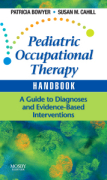
Pediatric occupational therapy handbook: a guide to diagnoses and evidence-based interventions
Bowyer, Patricia
Cahill, Susan M.
Combining essential assessment guidance with the latest evidence-based intervention strategies, this compact reference helps you quickly locate the information you need to evaluate and manage pediatric disorders. Access diagnosis-specific information on epidemiology, precautions, and more, as well as suggestedinterventions supported by the latest research, all in a convenient, pocket-sized handbook perfect for the busy clinical setting. Information is presented in a consistent format for easy reference and complies with the OT Practice Framework to help you ensure the most effective therapeutic outcomes. INDICE: Section I: Guide to Pediatric Practice 1. Using the Occupational Therapy Practice Framework in Pediatric Practice 2. Using Evidence to Guide Occupational Therapy Practice Section II: Guide to Diagnoses and Interventions 3.Achondroplasia 4. Acquired Brain Injury 5. Acquired Immunodeficiency Syndrome6. Albers-Schonberg Disease 7. Amblyopia 8. Anemia 9. Angelman's Syndrome 10.Anorexia 11. Anxiety 12. Apnea 13. Arthrogyposis Multiplex Congenita 14. Asthma 15. Attention Deficit Disorders 16. Autism Spectrum Disorders 17. Bipolar Disorder 18. Brachial Plexus Injury 19. Bronchopulmonary Dysplasia 20. Bulimia 21. Cerebral Palsy 22. Cleft Palate 23. Conduct Disorder 24. Congenital Clubfoot 25. Congenital Heart Defects 26. Congenital Obstructive Hydrocephalus 27. Cri Du Chat Syndrome 28. Cystic Fibrosis 29. Depression 30. Developmental Coordination Disorder 31. Disseminated Intravascular Coagulation 32. Down Syndrome (Trisomy 21) 33. Dysrythmias 34. Edward's Syndrome (Trisomy 18) 35. Epilepsy (Seizure Disorder) 36. Fetal Alcohol Syndrome 37. Fragile X Syndrome 38. Galactosemia 39. Gastrochisis 40. Hemophilia 41. Hydrocephalus 42. Hyperbilirubinemia 43. Hypoxic-ischemic Encephalopathy 44. Intellectual Disabilities 45. Intraventricular Hemorrhage 46. Juvenile Diabetes 47. Juvenile Rheumatoid Arthritis 48. Klinefelter's Syndrome 49. Learning Disabilities 50. Legg-Calve-Perthes Disease 51. Lesch-Nyhan Syndrome 52. Lordosis 53. Marfan Syndrome 54. Meconimum Aspiration Syndrome 55. Micrognathia 56. Mononucleosis 57. Muscular Dystrophy 58. Necrotizing Enterocolitis 59. Neonatal Respiratory Problems 60. Neurofibromatosis 61. Nystagmus 62. Obesity 63. Oppositional Defiant Disorder 64. Osteogenesis Imperfecta 65. Patau's Syndrome (Trisomy 13) 66. Periventricular Leukomalacia 67. Persistent Pulmonary Hypertension 68. Phenylketonuria (PKU) 69. Pica 70. Post Traumatic Stress Disorder (PTSD) 71. Pneumonia 72. Prader-Willi Syndrome 73. Retinopathy of Prematurity 74. Rheumatic Heart Disease 75. Scoliosis76. Separation Anxiety and Social Phobia 77. Sensory Processing Disorder 78. Sepsis 79. Sickle Cell Anemia 80. Spina Bifida 81. Spinal Muscular Atrophy 82.Strabismus 83. Tay-Sachs Disease 84. Tourette's Syndrome Appendix A: Websitesfor Research Appendix B: Assessment Tools
- ISBN: 978-0-323-05341-9
- Editorial: Mosby
- Encuadernacion: Rústica
- Páginas: 416
- Fecha Publicación: 14/10/2008
- Nº Volúmenes: 1
- Idioma: Inglés
